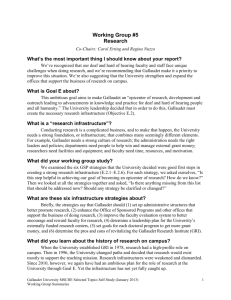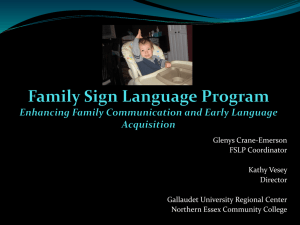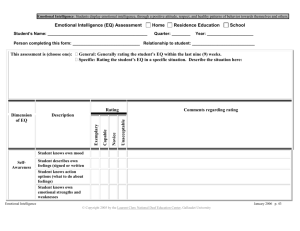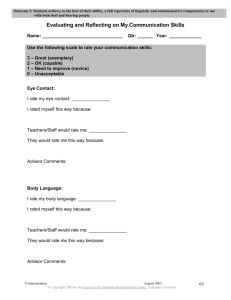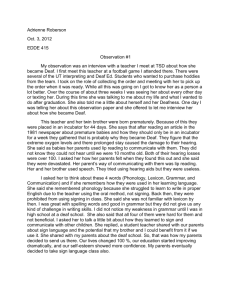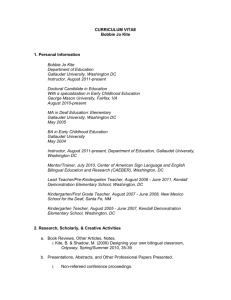Edward Miner Gallaudet and the Sign Language Debate
advertisement
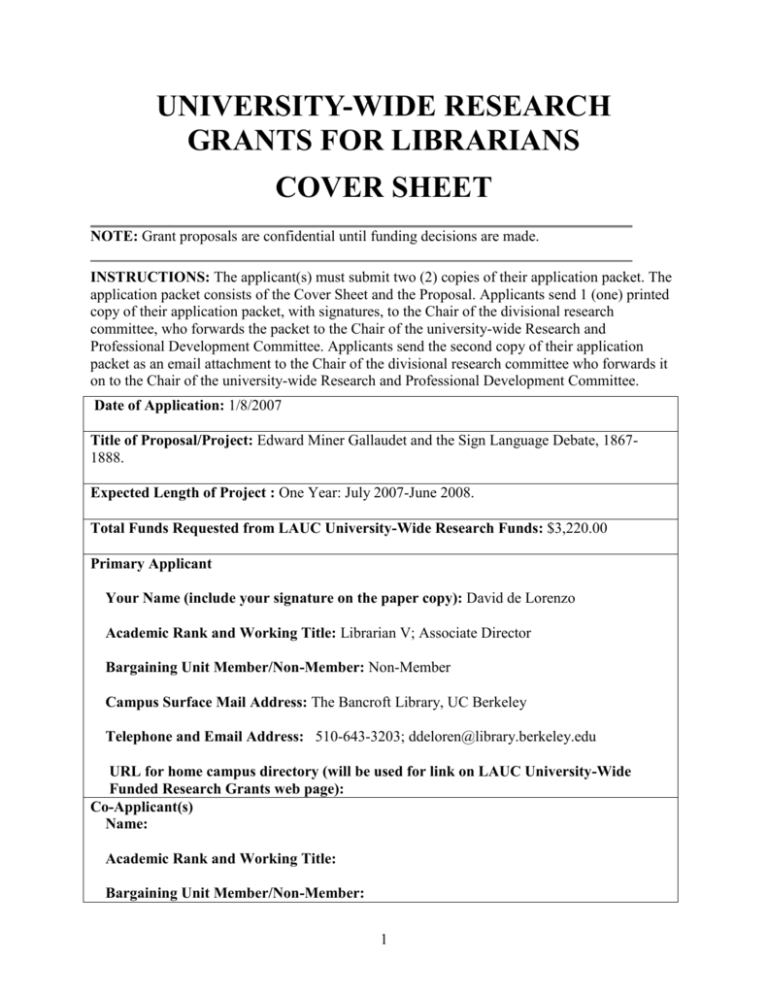
UNIVERSITY-WIDE RESEARCH GRANTS FOR LIBRARIANS COVER SHEET NOTE: Grant proposals are confidential until funding decisions are made. INSTRUCTIONS: The applicant(s) must submit two (2) copies of their application packet. The application packet consists of the Cover Sheet and the Proposal. Applicants send 1 (one) printed copy of their application packet, with signatures, to the Chair of the divisional research committee, who forwards the packet to the Chair of the university-wide Research and Professional Development Committee. Applicants send the second copy of their application packet as an email attachment to the Chair of the divisional research committee who forwards it on to the Chair of the university-wide Research and Professional Development Committee. Date of Application: 1/8/2007 Title of Proposal/Project: Edward Miner Gallaudet and the Sign Language Debate, 18671888. Expected Length of Project : One Year: July 2007-June 2008. Total Funds Requested from LAUC University-Wide Research Funds: $3,220.00 Primary Applicant Your Name (include your signature on the paper copy): David de Lorenzo Academic Rank and Working Title: Librarian V; Associate Director Bargaining Unit Member/Non-Member: Non-Member Campus Surface Mail Address: The Bancroft Library, UC Berkeley Telephone and Email Address: 510-643-3203; ddeloren@library.berkeley.edu URL for home campus directory (will be used for link on LAUC University-Wide Funded Research Grants web page): Co-Applicant(s) Name: Academic Rank and Working Title: Bargaining Unit Member/Non-Member: 1 Campus Surface Mail Address: Telephone and Email Address: Proposal Abstract (not to exceed 250 words): Edward Miner Gallaudet, the founder and first president of Gallaudet College, led proponents of the use of American Sign Language in their debate with proponents of the oral method, led by Alexander Graham Bell. This debate began in 1867 and climaxed at an International Conference in Milan, Italy in 1888. The issues presented in the debate had farreaching implications and reflected changing attitudes of the general population. It questioned not only its use in instruction but its fundamental usefulness to deaf people generally. It challenged the right of the Deaf to determine their own identity and culture. This proposal requests funding support to pursue research into this important national debate for the purpose of publishing an article on the topic. The personal papers of both Bell and Gallaudet are located in Washington, D.C. and travel support is requested for two trips, one week each trip. Research will focus not only on the role that Bell and Gallaudet played but also uncover what influence educators, politicians, parents, the Deaf and others had in shaping an outcome in which, by 1900, most schools for the Deaf had banned the use of sign language. Does the proposal require any of the following: Use of UC Library facilities or other site(s) requiring prior approval (Yes/No): No If yes, include signature and position of person authorized to permit use of facilities on paper copy of application: Release time (Yes/No): No If yes, include signature(s) of person(s) authorized to approve release time on paper copy of application: Use of Human Subjects (Yes/No): No If yes, attach appropriate university form to paper application form. The process of obtaining IRB approval or a determination of exemption from subject protection regulations does not have to be completed prior to submitting your grant proposal. However, the grant cannot be awarded without evidence that the approval or exemption has been obtained. List any previous grant proposals (divisional and university-wide) from this program that have been awarded to the primary applicant or co-applicants by title. Include date of completion and amount funded: n/a Budget Summary Total amount requested from LAUC statewide research funds: $3,220.00 Total amount requested from LAUC divisional research funds: Other funding obtained or expected (amount and source): 2 Fiscal Year of Application (fiscal year that funding begins): FY 07-08 New Project (Yes/No): Yes Supplemental Funding (Yes/No): No Salaries: Total Salaries: Supplies: Total Supplies: Travel: $820.00 Total Travel: $820.00 Other Expenses: $1,632 (Hotel); $768 (Food) Total Other Expenses: $3,220.00 Total State-Wide Research Funds Requested: Revised 9/2006 bhg 3 A PROPOSAL TO LAUC UNIVERSITY-WIDE RESEARCH GRANTS FOR LIBRARIANS EDWARD MINER GALLAUDET AND THE SIGN LANGUAGE DEBATE, 1867-1888 SUBMITTED BY DAVID DE LORENZO UNIVERSITY OF CALIFORNIA, BERKELEY JANUARY 2007 4 Edward Miner Gallaudet and the Sign Language Debate, 1867-1888 Table of Contents Pages Cover Sheet ………………………………………………1-3 Need for Research ………………………………………. 6-8 Design and Methodology ……………………………….. 8-9 Brief History of Gallaudet and Sign Language ………... 10-15 Selective Bibliography ………………………………….. 15 Budget …………………………………………………… 16 Supplemental Budget Sheet …………………………….. 17 Timetable for Completion ………………………………. 18 Curriculum Vitae………………………………………… 19-24 5 NEED FOR RESEARCH INTRODUCTION In the history of the disabled in the United States, few people hold such high esteem as Edward Miner Gallaudet. His father, Thomas Hopkins Gallaudet, was founder and first principal of the American School for the Deaf in Hartford (1817), the first publicly supported school for deaf students in the United States. His mother, Sophia Fowler, was profoundly deaf and had been a pupil of Thomas Hopkins Gallaudet. With this background, it is no wonder that Gallaudet's life-long work was in the field of deaf education. Gallaudet introduced a combined communication system that integrated oral methods (lipreading and speech) into the strictly sign language-only residential schools in the United States. He advocated the use of such a “combined” method of instruction when most of the world had changed to oral instruction. He established the first college program for deaf students in the United States, and brought about the establishment of a graduate training program at Gallaudet College for teachers of deaf students. His profound sensitivity to the needs of deaf people and his understanding of their potential for educational advancement single him out in the history of deaf education in the United States. Unfortunately, very little has been written about him and his place in American history. Due probably to the language barrier and the fact that the deaf community has always been regarded as a minority community, historians have written little more than narrowly-focused and superficial treatises on the American Deaf Community. Only two book-length works have been written about Gallaudet and his role in that Community. In 1959, a biography, written as a dissertation requirement, provided cursory coverage of his activities, depended completely in form and substance on Gallaudet’s own writings. Another dissertation, published in 1981, focused narrowly on the debate between Gallaudet and Bell. It lacked a comprehensive perspective that should have 6 included supporting references from other individuals also involved in the controversy and an analysis of events that lead up to their antagonism. The author also tended to be more enamored with Bell than with Gallaudet. Answers to many questions in the sign language debate still require discovery. Although we know much about the positions of Bell and Gallaudet, this represents only a fraction of the story. Events of such large proportion, having such an enormous influence on the lives of an entire community, are the result of the interaction of various participants. Key individuals on both sides of the issue wrote extensively to both Bell and Gallaudet. The record of their involvement will be explored and fleshed out. This story is as much about politics as it is about differences of social philosophy or educational theory. Bell had access to large sums of money and welded influence as a famous inventor with politicians and public administrators. Gallaudet had years of success in gaining financial support from the U.S. Congress and, he too was quite effective in swaying opinion. However, none of these maneuverings have ever been studied and described. Any story about the education of the Deaf and sign language is incomplete without focusing on the influence of parents of deaf children and the Deaf themselves had on it. Unfortunately, no scholar has ever ventured to uncover this aspect of the story, which can indeed be found in the papers of Bell and Gallaudet. Gallaudet’s Presidential papers are replete with letters from parents making demands for improved housing, advising on curriculum matters, inquiring about their child’s progress, etc. The Deaf were certainly not silent during this debate. Every school had an active printing press operation producing weekly newspapers touching on the subject. Incredible as it may seem, these resources have never been plumed. The final product of this research will produce a fuller coverage of the debate between Bell and Gallaudet. It will offer an analysis of the influence of educators and deaf educational 7 organizations in the debate. Sources will be evaluated to determine the role of politicians and public administrators and their influence on public policy at the state and national level. It will offer a synopsis of the influence of parents, the perspective of the Deaf during the debate, and review the place of this debate in the social history of the United States. DESIGN AND METHODOLOGY This proposal seeks funding to support research in Washington, D.C. where the collections about the sign language debate reside. The Principal Investigator submitting this proposal has had significant involvement in the deaf community for over twenty-five years. He edited Gallaudet’s history of the college (1983), and has published and spoken about Gallaudet. An article on the topic will be completed and submitted to various journals, including the American Annals of the Deaf. As seen from the cursory summary of Gallaudet’s career and his involvement in the education of the Deaf (below), the scope and extensive content of this debate will require two trips (5 days each trip) to Washington, D.C. to build out a more substantive account of his work in the area of educating the Deaf. This study will certainly encompass not only the political issues surrounding the debate but must also focus on the educational and social issues that sustained it. Both the personal and presidential papers of Gallaudet and the personal papers of Bell are located in Washington, D.C. In addition, the personal papers of other individuals involved in the debate, such as members of the Gallaudet faculty and the Volta Bureau (which Bell founded to promulgate oralism) staff, are also locate there. Gallaudet University Library also has the most comprehensive collection of secondary material on the Deaf and deaf education, such as deaf school newspapers, deaf education organization reports, serials, published monographs, etc. This request for two trips is based upon lengthy experience with the topic and an in-depth knowledge of the general scope of the collections involved. For a recent research trip focusing on Gallaudet’s leadership in the first years of the Columbia Institution, the P.I. found five days 8 sufficient to acquire pertinent documents to develop a paper on Gallaudet’s early leadership of the college for presentation at an upcoming conference. The timeline included in this proposal also provides detailed information about the process involved in this project. Before traveling to Washington, D.C., research of existing secondary sources will occur to develop notes and prepare questions and strategies for the first research trip. On the first trip, research visits will be undertaken to the Library of Congress Manuscripts Division to review E.M. Gallaudet papers and A.G. Bell papers. In addition a research visit will also be taken to the Volta Bureau to review A.G. Bell and oral proponent’s papers. Upon return from D.C., a review of notes and photocopies made on the first trip will be made and further questions and strategies for the next research trip will be developed. On the second trip a research visit to the Gallaudet University Archives to review E. M. Gallaudet’s presidential papers, personal papers of sign language proponents and published reports, articles, etc. will be undertaken. In addition, another research visit to Library of Congress to review additional papers identified in previous trip will likely occur. Upon return from the second trip, a review notes and photocopies will be made to verify sources and references discovered in both trips. An outline of the article will be made and a draft of specific segments initiated. A complete first full draft of article will be made with edits and checks to verify citations. This draft will be shared with selected colleagues for copy editing and comments. After this is completed, the finished article will be sent to selected journals for publication. 9 A BRIEF HISTORY OF GALLAUDET AND SIGN LANGUAGE COMBINED METHOD OF INSTRUCTION In 1867 Gallaudet traveled to Europe to study the methods of teaching deaf students in the schools of Europe. This trip was made partly in reaction to the establishment of two oral-only schools, the Lexington School for the Deaf in New York City (formerly the New York Institution for Impaired Instruction), and the Clarke Institution for Deaf Mutes in Northampton, Massachusetts. Gallaudet realized that the oral methodology had great enticement for parents and the public at large. On his return from Europe, he presented a report to the board of directors of the Columbia Institution supporting the use of oral instruction as an additional method of educating deaf students. He strongly believed manual communication was equally important and should be used in a combined-method approach. Although there is great debate today regarding his definition of combined method, it appears Gallaudet had oral instruction established at his own school as a separate classroom subject. Courses in geometry, philosophy, English literature, and so on were taught by using sign language, the student's "natural" language. Students would then attend separate classes in articulation and lip-reading. Those students who demonstrated little or no success in these classes were not forced to attend. Gallaudet also called for a conference of principals of schools for the deaf across the country to meet at the Columbia Institution so that this and other issues could be discussed. Since 1861 the exchange of ideas and the discussion of problems had halted, because of the Civil War. Gallaudet circulated an invitation to the principals of the institutions in the United States to meet at Kendall Green on May 12,1868. Some controversy did arise in that no oral proponent was invited, but Gallaudet defended his selection of participants, saying that the conference was intended for only superintendents of schools for the deaf. Since the Clarke School and the Lexington School had no principals at that time, these schools could not be represented at the conference. 10 At the conference, Gallaudet presented his proposal for a combined-method approach, which he hoped, would act as a national method for educating deaf students. Gallaudet premised such a change in methodology on the fact that the schools had failed to teach their students to express themselves adequately in written English. Gallaudet was convinced that the chief aim of education of deaf persons was to provide this basic but essential skill. He also cited other factors which attributed to poor English language skills: the excessive use of sign language which did not follow English grammatical rules, poorly trained teachers in schools for deaf pupils, and a lack of adequate textbooks that could be used with deaf children. Gallaudet reiterated these concerns at the Seventh Convention of American Instructors of the Deaf in 1870. Although he was an ardent proponent of sign language and considered it his mother tongue, he believed a combined-method approach would overcome the major obstacle prohibiting deaf students from acquiring acceptable written English skills. Many supporters of sign language were outraged by the thought of having oral instruction introduced to the schools and believed it would only end in failure. However, many superintendents agreed to begin implementing this philosophy, and soon it became a national method for educating deaf persons. In this regard, Gallaudet played a pivotal role in gaining acceptance of a combined oral/manual philosophy. ORALISM and ALEXANDER GRAHAM BELL In his work with educating deaf students, Gallaudet met one opponent with whom he was unable to compromise; this was Alexander Graham Bell. In his early years, Bell taught speech by using a system developed by his father, called Visible Speech, and demonstrated his methods at the Clarke and Hartford schools. Bell received a patent for his invention, the telephone, in 1876, and three years later moved to Washington, D.C., where he met Edward Miner Gallaudet. Bell believed in a strictly oral methodology in educating deaf children and refused to 11 compromise with the use of sign language. Bell felt that the use of sign language would prohibit a student from learning speech and lip-reading. While Bell dealt mainly with rich constituencies ready to donate vast sums to his cause, Gallaudet was an egalitarian who saw himself as a spokesman for the people who constituted the community. Although Bell and Gallaudet could not come to terms in their philosophies regarding deaf education, they did not become outspoken opponents until Gallaudet attempted to establish a graduate program in education, titled the Normal Department, at the college. In 1880 both were on such good terms that Bell received an honorary Ph.D. from the college. In the summer of 1880 Gallaudet attended the International Congress of Instructors of the Deaf, in Milan, Italy. James Denison, the only deaf participant from the United States, accompanied Gallaudet. The vast majority of participants at the Milan Congress were from Europe. The largest group was Italians who vehemently supported the oral methodology for educating deaf students. The Congress approved several resolutions stipulating that the oral methodology was superior to the manual method of instructing deaf persons. This action was based partly on demonstrations showing the effectiveness of the oral method at the International Congress by students taught with that method exclusively. Gallaudet complained that the students who demonstrated their speech skills were mainly post-lingually deaf and had been tutored what to say before the actual demonstrations. Gallaudet also felt that the Congress was not in fact international in character, nor was its composition representative of international opinion. Only 21 of the 164 members of the Congress were from countries other than Italy and France. The Congress did, however, mark a turning point in the attitudes of educating deaf children in the United States. Oral propagandists used it successfully as a symbol of support for the oral methodology, and by the end of the nineteenth century there were 18 strictly oral schools in America and all others were requiring oral methods in their curriculum. 12 Gallaudet did not retreat in the face of this changing tide in support of oralism. He continued his support for a combined methodology that would satisfy the varying needs of children whose deafness fell into a variety of categories. In 1886 he was invited to appear before the Royal Commission of the United Kingdom for the Deaf and Dumb. Spurred by the declarations of the Milan Congress, the commission was established to investigate methods of educating deaf students of the United Kingdom. Gallaudet presented his testimony in support of the combined method and was well received. Several requests were made to Gallaudet in 1890 to establish a Normal Department in the Columbia Institution, in which young men and women having all their faculties would be trained to be teachers of deaf students under the two principal methods being used. Gallaudet proposed to Congress in 1891 an appropriation that would establish the Normal Department. To Gallaudet's surprise, Bell asked to be heard by the House Appropriations Committee in opposition to the measure. Gallaudet had a long conversation with Bell and found that his opposition to the establishment of the Normal Program was based on what he understood the purpose of the program to be, that is, to train deaf teachers. Gallaudet flatly denied this would happen and assured Bell that no deaf person would be admitted to the Normal Department. Gallaudet also assured him that all of the students would be thoroughly trained in the oral method of teaching. Bell, however, appeared before the Appropriations Committee and asserted that the purpose of establishing this program was to train deaf teachers of deaf children. He opposed the establishment of the program specifically on this ground. Gallaudet was appalled by Bell's interference, ignoring discussions that he and Bell had had together regarding the Normal Department. Bell's testimony before the House Appropriations Committee did not change their decision, but Bell carried the controversy over to the Senate Committee, securing petitions against the measure from a number of oral schools. 13 In the Senate Committee, Bell succeeded in getting the appropriation of $5000, which Gallaudet had requested, cut down to $3000 and given only for the payment for articulation teachers. Bell felt he had defeated the establishment of the Normal Department, but the appropriation was used by Gallaudet to carry forward the establishment of the Normal Department exactly as planned. Although Gallaudet and Bell did later attempt reconciliation, Gallaudet stated in his diaries, "the hatchet is buried but I know where it is." Further animosity developed over Gallaudet's proposal to merge their respective organizations: Bell's American Association to Promote the Teaching of Speech to the Deaf (AAPTSD) and Gallaudet's Convention of American Instructors of the Deaf (CAID). Bell initially seemed agreeable to the union and showed an interest in pursuing the matter at the AAPTSD meeting at Chautaugua, New York, in July 1894. By the end of the meeting, though, no agreement had been reached and several members had spoken openly against a merger. Gallaudet was especially irritated by Bell's enthusiasm to allow as members wealthy promoters who had no affiliation or expertise in deafness. Bell suggested committees be formed by the respective organization to discuss a proposal by the AAPTSD that would allow the creation of three distinct groups. Gallaudet considered the proposal absurd. He perceived these machinations by Bell to be deliberate attempts to lead him on, when in reality Bell had no intention of merging the two organizations. Gallaudet decided to speak out openly against Bell and oralism and chose the July 1895 CAID meeting at Flint, Michigan, as his battleground. In his paper, read before the whole convention, Gallaudet summarized his dealings with Bell during the past five years. He accused Bell of fanaticism over the pure oral method and called him an outsider who had succeeded only in undermining the professionals working in deaf education. He stated openly that union of the two organizations failed due to Bell's autocratic manipulations of members of the AAPTSD. Gallaudet maintained that Bell's organization was unprofessional in character and "essentially a body of 14 promoters," the majority of whom were not actual instructors of the deaf. Bell was given an opportunity the next day to respond, but Gallaudet viewed his statements as “lame and impotent.” Bell and Gallaudet made no further attempt to speak to one another until five years later. Selective Bibliography Ambrosen, Lloyd A.: Contributions of Edward Miner Gallaudet to the Convention of American Instructors of the Deaf, Master's Thesis, Gallaudet College, 1942. Boatner, Maxine T.: Voice of the Deaf: A Biography of Edward Miner Gallaudet, Washington, D.C., 1959. "Edward Miner Gallaudet Papers," Gallaudet College Archives, Washington, D.C. "Edward Miner Gallaudet Papers," Manuscripts Division, Library of Congress, Washington, D.C. Gallaudet, Edward Miner. History of the College for the Deaf. Washington, D.C.: Gallaudet University Press, 1983 (David de Lorenzo and Lance Fischer, eds.) Prater, Lorraine: Dr. Edward Miner Gallaudet: His Views on the Oral Method, the Sign Language and the Manual Alphabet as a Means of Educational Instruction, Master's Thesis, Gallaudet College, 1941. Winefield, Richard M.: Bell, Gallaudet and the Sign Language Debate: An Historical Analysis of the Communication Controversy in Education of the Deaf, Doctor's Thesis, Harvard University, 1981. 15 E.M. Gallaudet Proposal Budget Request LAUC Committee on Research BUDGET DETAIL FOR THE PERIOD FROM July 1, 2007 TO June 30, 2008 1. TRAVEL to Washington, D.C. -- August 2007 (6 nights) LAUC Hotel (Gallaudet Hotel & Conference Center @ $136/day $816 Airline (Roundtrip Oakland Airport to Reagan National Airport) $410 Meals & Incidentals (6 days @ $64/day) $384 TOTAL COSTS: $1,610.00 2. TRAVEL to Washington, D.C. -- October 2007 (6 nights) Hotel (Gallaudet Hotel & Conference Center @ $136/day $816 Airline (Roundtrip Oakland Airport to Reagan National Airport) $410 Meals & Incidentals (6 days @ $64/day) $384 TOTAL COSTS: TOTAL PROJECT COSTS: $3,220.00 16 $1,610.00 Librarians Association of the University of California SUPPLEMENTAL BUDGET INFORMATION This Sheet Must Accompany the Grant Application PER DIEM Please indicate the source of the per diem rates used in the application a. b. c. d. Federal Government XX University XX Other _____________________________________________________ Other _____________________________________________________ Location Rate 1. Washington, D.C. 2. Washington, D.C. 3. 4. 5. Source $64.00/day (Meal and Incidental Expenses) $136/day ($195 Max. Lodging allowed) UCB/CONUS UCB/CONUS TRAVEL Please indicate the source of the travel information used in the application a. b. c. d. e. Location Federal Government University XX Internet Search (list which service used)____________________ Travel Agency Other ________________________________________________ Type Amount 1 Washington, D.C. (Reagan National) Airline $410 2. 3. 4. 5. 6. 17 Rate Source Roundtrip UCB Travel Vendor Edward Miner Gallaudet and the Sign Language Debate, 1867-1888. PROJECT TIMELINE JULY 2007 Research existing secondary sources to develop notes and prepare questions and strategies for first research trip. AUGUST 2007 Research visit to Library of Congress Manuscripts Division to review E.M. Gallaudet papers and A.G. Bell papers Research visit to Volta Bureau to review A.G. Bell and oral proponent’s papers SEPTEMBER 2007 Review notes and photocopies and prepare questions and strategies for next research trip. OCTOBER 2007 Research visit to Gallaudet University Archives to review E.M. Gallaudet’s presidential papers, personal papers of sign language proponents and published reports, articles, etc.. Research visit to Library of Congress to review additional papers identified in previous trip. NOVEMBER 2007 - MARCH 2008 Review notes and photocopies to verify sources and references discovered in research. Begin outline of article and draft of specific segments. APRIL - JUNE 2008 Complete first full draft of article. Begin edit of first draft. Check and verify citations. Share formal draft with selected colleagues for copy editing and comments. JULY 2008 Submit finished article to selected journals for publication. 18 David de Lorenzo The Bancroft Library University of California, Berkeley 510-643-3203 510-642-7589 (FAX) ddeloren@library.berkeley.edu Curriculum Vitae I. ACADEMIC PREPARATION 1979 M.S. (Library Science), Simmons College 1976 B.A. (History), Wabash College II. RELEVANT EMPLOYMENT HISTORY 2001-present Associate Director & Head of Technical Services The Bancroft Library, University of California, Berkeley Responsibilities: Manage all aspects of library’s technology initiatives and collection management including, acquisitions, appraisal, cataloging, copy cataloging, serials, and arrangement and description of manuscript and pictorial collections. Supervise 27 FTE staff and 17 student assistants. Administer all collection-related projects involving database management, EAD/TEI encoding, digital imaging, e-text conversion, metadata creation, and Web access. Manage budget of $2 million including federal, state, and foundation funds. 2003-present Lecturer College of Library and Information Studies San Jose State University, San Jose, CA Responsibilities: Archives and Manuscripts Administration (LIBR 256); Records Management (LIBR 257) 1997 - 2001 France-Merrick Director of the Library Maryland Historical Society, Baltimore, MD Responsibilities: Administer all aspects of the library, 10 FTE staff, budget ($425K), facility, collection development, technology initiatives, grants and donor relations, outreach programs, and library exhibitions. Administer manuscript collections (the largest collection in the State dating from Colonial period), prints and photographs, historic maps, 1.5 million items of ephemera, rare books and pamphlets, 3,000 microfilm, 75,000 titles supporting genealogy research, and 225 newspaper and serial titles. 1998-2001 Reference Librarian, Telephone Reference Services Department Enoch Pratt Free Library, Baltimore, MD Responsibilities: Provided after-hours telephone reference services to state-wide patrons requesting general and specific information about every and any topic. 2000 Adjunct Lecturer College of Library and Information Science University of Maryland, College Park, MD Responsibilities: Management & Administration of Manuscript Collections (LBSC 782) 1988 - 1997 Curator of Manuscripts and Archives Harvard Law School, Cambridge, MA Responsibilities: Managed all aspects of the manuscripts and archives department 19 including collection development, grants, outreach, donor solicitations, and exhibitions. Administered modern manuscript/archival collection of 5,000 collections (the second largest holding of legal manuscripts in the United States), a medieval and renaissance manuscript collection of 3,000 items, and 35,000 book titles. 1980 - 1988 University Archivist and Head of Special Collections Gallaudet University, Washington, D.C. Responsibilities: Managed all aspects of the University Archives and Special Collections Department, the Records Management Program and University Museum including staff supervision, budgets and grants, collection development and donor relations, and outreach and exhibitions. Managed a manuscript collection of 3,000 linear feet, university archives of 2,000 linear feet, and 100,000 photographs. 1984 - 1988 Adjunct Lecturer Gallaudet University History Department Responsibilities: Introduction to U.S. History (Colonial Period to Reconstruction Era) (HIST 205), Introduction to Material Culture Studies (HIST 569). III. LIBRARY AND SCHOLARLY PROJECTS A. GRANT PROJECTS Topic E. M. Gallaudet President’s Papers Italian American Web Project Environmental Collections Project Arthur Brown Architectural Records Women Political Activists Archives NAACP Records Project African American Web Project Papyrus MrSid Enhancement Project David Brower Papers Project Hoffman Papers Project Hearst Family Papers Project San Francisco Earthquake Project Disability Rights Archiving Project Museum Online Archive Collaboration California Cultures Digital Project Eubie Blake Digital Jazz Archives Md. County Historical Societies Catalog Maryland Icons Project Photograph Cataloging Project Library Renovation & Recon Project Hughes Photograph Project Finding Aids Digitization Project Nuremberg War Crimes Records Medieval Charters and Deeds American Legal Manuscripts MARC VM Format Conference Historic Sources Survey of Deaf Schools Dates Funding Agency 11/06-10/07 01/06-12/06 01/06-12/06 07/05-12/06 8/03-02/06 8/02-6/04 10/02-12/03 9/02-12/03 6/01-6/04 6/02-6-04 1/02-12/04 10/01-10/05 7/01-8/03 6/01-12/02 9/01-8/05 6/2001 1/00-6/01 5/99-5/00 10/98 -10/00 10/97-5/00 12/97-7/99 7/98-12/99 1/95-12/96 5/93-5/95 2/88-5/90 6/87-12/87 7/84-11/86 20 Gallaudet University Alumni Fund Italian American Foundation Gilbert Foundation Getty Foundation NHPRC NHPRC Wells Fargo Foundation Gladys Krieble Delmas Foundation Power Bar Corporation Giannini Foundation Hearst Foundation California LSTA Grant U.S. Dept. of Education IMLS NEH IMLS Maryland Dept. of Education Save America’s Treasures, NPS Andrew W. Mellon Foundation NEH NHPRC Clayton Foundation The Schumann Fund Lurcy Charitable Trust Univ. Publications of America NHPRC NHPRC B. FELLOWSHIPS, AWARDS, CERTIFICATION, Etc. ●ACRL/Harvard Leadership Institute, Harvard University, 2004. ●NHPRC Historical Editing Fellow, Wisconsin Historical Society, June 2003. ●The Katherine and Daniel Leab Exhibition Catalog Award, American Library Association (for History In Deed: Medieval Society and the Law in England, 1100-1600), 1995. ●Mellon Fellow, Bentley Historical Library, University of Michigan, Summer 1987. Research Topic: Analysis of the Effectiveness of Online Catalogs from a User Perspective. ●Research Award, Gallaudet Research Institute, Small Grants Program. Research Topic: Gallaudet College and the Sign Language Debate, Summer 1987. ●Silver Award, Council for Advancement and Support of Education, Institutional Relations and Alumni Relations Publications (for Guide to the Gallaudet University Archives), 1986. ●Certified Records Manager, Institute of Records Managers and Administrators, March 1984. ●Research Award, Laurent Clerc Cultural Fund, (for) Edward M. Gallaudet History Project, 1984. ●Certificate in Archives Administration, Modern Archives Institute, National Archives, January 1982. C. SELECTED PAPERS, LECTURES, PRESENTATIONS A Legacy of Leadership: Edward Miner Gallaudet and the Columbia Institution for the Deaf, 1857-1864. Centennial Celebration Symposium. Gallaudet University. April 2007. Session Chair. The Invisible Web and More. Annual Meeting of ARLIS/NA, Baltimore, March 2003. Law Publishing in the History of Maryland Printing. Talk given at the Education Lecture Series, Maryland Historical Society, January 2001. Meeting Chair and Host, Visual Resources Association Mid-Atlantic Chapter Meeting, Friday October 6, 2000. Archival Employment: Perspectives from Employers and Employment Seekers. Paper presented at MARAC Fall Meeting, October 2000. Old Wine in New Skin: The Managerial Transition to a New Workplace. Paper presented at MARAC Spring Meeting, May 2000. About Our Roots: A Status Report on Maryland Genealogy Resources. Paper presented at the Annual Meeting, Maryland Genealogy Society, March 2000. The Future Is Now: A Strategic Plan for Independent Research Libraries. A Tour and Talk hosted by the Maryland Historical Society Library for the Annual Meeting, America Association for State and Local History, September 1999. How to Research Maryland History Using Electronic Resources, a monthly weekend educational series presented at the Maryland Historical Society Library, May 2000 – May 2001. Meeting Chair and Host. To Preserve: Preservation of Library Materials, Meeting of the Maryland Chapter, Special Libraries Association, April 1999. An Analysis of the Deed of Gift Agreement in Relation to Property and Contract Law. Paper presented to the Annual Meeting, Society of American Archivists, Chicago, August 1997. The Future of Federal Electronic Records: The PROFS Litigation Updated. Paper presented at the National Association for Government and Records Administrators. Annual Meeting, Washington, D.C., July 1996. 21 Debate on the Destruction of Federal Records: The PROFS Litigation. Session Chair, Annual Meeting, Society of American Archivists, Washington, D.C., Sept. 1995. Breaking the Law: Archiving Lawyer Client Files. Session presented at the Annual Meeting, Society of American Archivists, Indianapolis, Sept. 1994. Use and Users of Historical Repositories. Paper presented at the Spring Meeting, New England Archivists, April 1993. A Judgment Notwithstanding the Verdict: Evaluating Use at a Legal History Repository. Paper presented at the Annual Meeting of the Society of American Archivists, Philadelphia, Sept. 1991. Every Tub Has A Bottom Line: A Study of Use and Users at Harvard Repositories. Paper presented at the annual Harvard University Libraries Symposium, September 1990. How Archives Are Used. Paper presented at the Annual Meeting of the Society of American Archivists, Atlanta, October 1988. Patron Access to Unpublished Library Collections Using Online Catalogs. Paper presented at the Annual Meeting of the Association for College and Research Libraries, Cincinnati, March 1988. Access Questions Involving Archival Online Systems. Paper presented at the Midwest Archives Conference, Chicago, May 1988. Preserving Interviews Using American Sign Language: Gallaudet Oral History Program. Paper presented at the Annual Meeting of the Oral History Mid-Atlantic Region (OHMAR), Washington, D.C. March 1988. Preserving Documentation of the American Deaf Community. Paper presented at the Annual Meeting of the American Culture Association, Louisville, April 1986. Cataloging Visual Collections. Paper presented at the Annual Meeting of the Art Libraries Society, Washington, D.C., Feb. 1985. Session Chair. Archiving the American Deaf Community. Annual Meeting of the Society of American Archivists, Sept. 1983. D. SELECTED PUBLICATIONS & EXHIBITIONS Maryland In Focus: The History of Photography in Maryland, 1840-1970. Exhibition. Maryland Historical Society, 2001. More than Meets the Eye: History of Maryland Through Prints, 1750-1900. Exhibition. Maryland Historical Society, February, 1999. Mapping Maryland: The Willard Hackerman Historical Map Collection. Exhibition and Catalog (66 p). Maryland Historical Society, 1999. Contributor. Directory of Manuscript Collections Related to Federal Judges, 1789-1997. Federal Judicial History Office, Federal Judicial Center, 1998. "From Leaves to Bytes: The Harvard Digital Finding Aids Project." (in) Finding Common Ground: Creating the Library of the Future Without Diminishing The Library of the Past. Cheryl LaGuardia and Barbara A. Mitchell (editors). New York: Neal-Schumann, 1998. 22 Contributor. Guide to the Preservation of Federal Judges Papers, Federal Judicial History Office, Federal Judicial Center, 1996. de Lorenzo, D.L., “Use and Users of A Legal History Repository,” Not Just The Facts: Varieties of Research in Historical Sources, Cambridge: Harvard University Library, 1993. History In Deed: Medieval Society and the Law in England, 1100-1600. Exhibition and Catalog (86 p.). Harvard Law School, 1993. Pioneers in Criminology and Criminal Justice: Sheldon and Eleanor Touroff Gleuck. Exhibition and Catalog (70 p.). Harvard Law School, 1992. “What A Medley of a Man:” Oliver Wendell Holmes. Exhibition and Catalog (45 p.). Harvard Law School, 1991. Contributor. MARC for Visual Materials: A Compendium of Practice. Chicago: Chicago Historical Society, 1987. de Lorenzo, D.L. “Edward Miner Gallaudet” (in) Encyclopedia of Deafness and the Deaf. New York: McGraw-Hill Book Co., 1987. de Lorenzo, D.L., A Guide to the Historical Collections at Schools for the Deaf in the United States. Gallaudet University Library, 1986. de Lorenzo, D.L., A Guide to the Collections at the Gallaudet University Archives. Gallaudet University Library, 1986. Contributor. MARC for archives and manuscripts : the AMC format (by) Nancy Sahli. Chicago: Society of American Archivists, 1985. de Lorenzo, D.L. (Editor) A History of the College for the Deaf, (by) Edward Miner Gallaudet. Washington, D.C.: Gallaudet University Press, 1983. IV. PROFESSIONAL SERVICE A. UNIVERSITY OF CALIFORNIA SERVICE --Chair, Task Force on Custodial Collections, 2006. --University Library Technical Services Council, 2002-2003. --Executive Committee (elected), Librarians Association (LAUC-B), 2003. --Board of Directors (LAUC Representative), Northern Regional Library Facility, 2003. --Task-Force on University Library Backlogs, 2002. --Task Force on the Bancroft Strategic Plan, 2004. --Bancroft Administrative Group, 2002--Bancroft Managers Committee, 2002--Bancroft Collections Acquisition Committee, 2002--Chair, Bancroft Technical Services Managers Committee, 2002B. MARYLAND HISTORICAL SOCIETY SERVICE --Co-Chair, MHS Board of Trustees, Library Committee --Chair, MHS Board of Trustees, Library Genealogy Committee --Chair, MHS Automation Committee --Chair, Library Renovation Committee 23 --Chair, Library Collection Development Committee --Member, Maryland Hall of Records Commission --Member, Baltimore Academic Libraries Consortium, 1999-2001 C. HARVARD UNIVERSITY LIBRARY SERVICE --Chair, University Special Collections Committee (ULC MAC) --Member, Digital Finding Aids Project (DFAP) --Member, Special Collections Task Force on HOLLIS II --Harvard-Radcliffe Archives Group (HRAG) D. PROFESSIONAL & COMMUNITY SERVICE --Vice President, Board of Directors, University Terrace Housing Association, 2006--Member, Online Archives of California (OAC) Committee on Finding Aid Access, 2001-2002 --Founding Member, Baltimore Art Resources Consortium (BAROC), 1998-2001 --Recording Secretary, Baltimore Bibliophiles, 2000-2001 --Chair, Reference, Access & Outreach Section, Society of American Archivists, 1998-1999 --Steering Committee, Reference, Access & Outreach Section, Society of American Archivists, 1996-97 --Vice President, Board of Trustees, Thornton W. Burgess Society, 1993-96 --Member (elected), Board of Directors, Sandwich Public Library, Sandwich, Mass., 1992-1994. --Member, Task Force on Organizational Effectiveness, Society of American Archivists, 1995-1996 --Chair, Committee on Law and Legislation, Society of American Archivists, 1993-1995 V. COMPUTER SKILLS & LANGUAGES Blackboard, Microsoft Office Suite, Word Perfect Suite, Netscape Suite, PhotoShop, HTML, XML, SGML (TEI & EAD), RLIN, OCLC, Integrated Library Systems (EOS, NOTIS, SIRSI, ExLibris, Voyager), MARC Formats for Bibliographic Description, American Sign Language (fluent) VI. PROFESSIONAL ASSOCIATION MEMBERSHIPS Society of American Archivists, Baltimore Bibliophiles (Life Member), California Society of Archivists, American Association for State & Local History. 24


